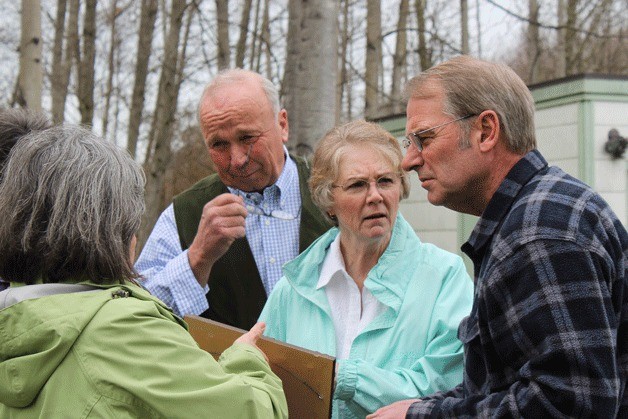Kathy Lunsford didn’t want to leave.
She had never been to the old farmhouse and barn steeped in her family’s history. Now that she was there as an invited guest to tour the home built by her great-great-grandfather Henry Riksen, the gravity of the experience made her stop and reflect.
She thought back to the difficult choices Riksen and other Dutch farmers from Oak Harbor’s Clover Valley made in the early 1940s when they gave up their farm land, homes and in many cases their livelihoods to make way for Whidbey Island Naval Air Station.
The Navy purchased about 70 farms at that time for the base. Riksen was paid $25,000 for his property on 135 acres.
“They made a tremendous sacrifice,” Lunsford said. “It’s not like you and I moving. It’s ‘take everything you’ve worked for — everything — and leave and start over again.’ These guys were probably 50- to 60-years old when they asked them to do it, and there’s no retirement there. Their retirement is the farm and their kids supporting them with the farm.”
It is these acts by farmers in Clover Valley that Lunsford is hoping to memorialize by preserving the Riksen farm and perhaps turning it into a museum.
She was one of about 30 guests, mostly Riksen descendents and their spouses, invited by the Navy to tour the home and barn Tuesday.
The Riksen place is one of eight old farmhouses on federal property near Ault Field being considered for removal.
Remodeled and used for decades as base housing, the aging structures have gradually been phased out, leaving their future up in the air.
Forest City Enterprises, which owns the properties and leases the land from the federal government, is working with the Navy to decide what to do with them.
The review could take close to a year, said Greg Raap, vice president for Forest City’s Northwest Region.
“We have no intention to use them as housing,” Raap said. “We just have to figure out what the right thing to do is. We want to do the right thing.”
Kendall Campbell, cultural resource program manager for NAS Whidbey, is working with Forest City and the Washington State Historic Preservation Office to determine the fate of the farmhouses.
She’s done extensive research on the properties in the past year, including speaking to relatives and others to better understand their importance to the community.
The review includes consulting with the state to determine if the farmhouses are eligible for listing on the National Register of Historic Places, Campbell said.
So far, the Riksen farm has emerged as the property the community is most interested in saving.
Many of the other seven farmhouses are no longer at their original sites.
Another farmhouse was restored and is being used for military housing, Raap said.
“We wanted to keep one representative example of the farmhouses operating,” Raap said. “The big question is, ‘What is appropriate for those remaining eight houses?’ I don’t know what the answer is.”
So far, much of the preservation efforts have focused on the Riksen farm, which includes a farmhouse and massive barn, among other structures.
Henry Riksen was among the first group of immigrants of Dutch descent who came to Whidbey Island from Michigan in the late 1800s attracted to the fertile farm lands. He settled in Clover Valley, built the farmhouse around 1900 and had a massive round top barn constructed using timber from the property.
The Navy invited Riksen descendents and others to tour the structures.
Among them was Oak Harbor’s Karen Van Dam, whose great-great-aunt Jane married Henry Riksen.
“This is a piece of our history,” Van Dam said. “It would be so neat if we could preserve it.”
Feedback from the tour is part of the process of measuring the property’s local historic importance.
These measures are sometimes difficult to determine.
“When you look at what makes a building significant, it’s feeling, characteristic, integrity,” Campbell said. “So what’s feeling?
“When I drive into Oak Harbor and I see something on the Seaplane Base, does it evoke a feeling, a memory? That’s hard to do.”
The Riksen farm visit stirred up plenty of memories and served as somewhat of a family reunion in the process.
Van Dam and Lunsford both would like to see consideration made to turn the farmhouse into a museum to honor both the early pioneers who farmed the land there and naval history. The property is on federal land but is located outside of the Langley gate with the sights and sounds of aircraft nearby.
Their hope was to see if the PBY Memorial Foundation might be interested in the site, however, that museum will be moving to the location of the former Whidbey Furniture store on Pioneer Way some time in May.
“It would be great for people to have a chance to see part of naval history and pioneer history,” Van Dam said.



